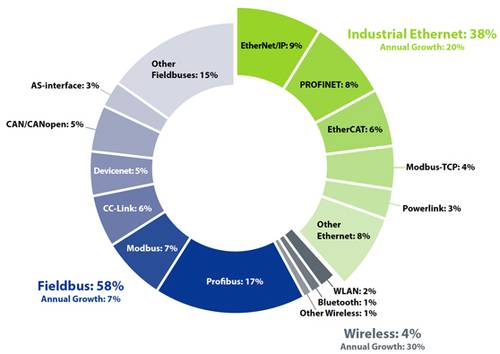EtherNet/IP vs Profinet – a Comparison
There are two clear leaders when it comes to Ethernet protocols – EtherNet/IP and Profinet.
Each command a whopping 30 percent of worldwide market share or 60 percent combined [1].
But why?
Are these networks truly superior? We say no. Neither network is as deterministic as Profibus, DeviceNet or ControlNet. Moreover, each requires complex and sophisticated measures to build performance into the protocol.
Addressing the popularity of these networks could take us back to the early “fieldbus wars,” such as the days of Fieldbus, Remote I/O and others. The clear winners of those wars were the manufacturers with the lion’s share of the connected devices, namely Rockwell Automation and Siemens. Network performance was yet another way to differentiate their product solutions.
Much of the same could be said today, but with a slight twist. While each manufacturer has simpler and more robust networks in their arsenal, both are sending signals that Ethernet will be the network of choice for the factory of the future. And each has a horse in the race.
Rockwell Automation purports EtherNet/IP, which is based on the same Common Industrial Protocol (CIP) that its entire family of networks is based on. In similar fashion, Siemens promotes Profinet, which is built on the Profibus model. Both are open networks that are backed by defined standards and extensive communities. EtherNet/IP is managed by the ODVA (Open Device Vendor Association) and Profinet is managed in the U.S. by PI North America.
As of 2016, Industrial Ethernet is growing at a rate of 20 percent [2], and makes up for 38 percent of the global market compared to 34 percent last year. Ethernet continues to displace other networks, including DeviceNet and Modbus. EtherNet/IP is No. 1, followed by Profinet. It also appears that EtherNet/IP is growing slightly faster than Profinet. Wireless technologies now represent 4 percent of the worldwide industrial network market.
Globally, Profibus remains the largest installed network and continues to grow in Europe. But Profinet has the fastest growth rate in Europe. Here in the U.S., CIP (Common Industrial Protocol) networks continue to lead. EtherNet/IP is the fastest growing and has even overtaken DeviceNet.
EtherNet/IP vs Profinet – a Comparison
There are numerous reviews available comparing performance of networks. Like the latest and best in class car reviews, they tend to hold a degree of bias. We tried to evaluate first with some hard data. The study [3] cited below reached a general conclusion that all Ethernet protocols perform suitably with a bandwidth of 1 Gb/s for interconnected real-time systems. However, at 100 Mb/s, some attention is required to ensure that Ethernet-based protocols will meet application requirements (i.e. higher speed feedback, motion).
What About Determinism?
Determinism is the limiting factor to overcome [4]. Standard Ethernet is notoriously non-deterministic, meaning we cannot guarantee that a message will arrive within a desired window of time. This has been the single greatest argument against Ethernet for years (in automation). Fieldbus networks such as Profibus and DeviceNet are significantly more deterministic than EtherNet/IP or Profinet.
However, the advancement of the protocol technology is winning. What EtherNet/IP and Profinet have shown is that speed and determinism must be evaluated against the actual application requirements. Discrete I/O, for example, typically requires a reaction in the 5-10ms timeframe. Higher speed, more demanding applications such as motion control require responses in the microsecond region.
Per the graph above, systems operating at speeds of less than 1 ms should have very little potential for deterministic failure. With many systems running between 10 ms and 100 ms, Ethernet-based systems are more than adequate for the job. Each protocol will continue to produce a faster and more deterministic Ethernet.
There is considerable interest in the advancement of Ethernet technology, and standards bodies such as IEEE are supporting the cause.
In 1990 IEEE began a set of standards (802) for networks [5], including specific standards for Ethernet. This collection includes the body of work of the Time Sensitive Network (TSN) task group. The purpose this task group is to “provide the specifications that will allow time-synchronized, low-latency streaming services through 802 networks.” In layman’s terms, TSN sets standards that will increase determinism of Ethernet protocols. While the TSN group has a focus on audio visual requirements, its work supports IEEE 1588 – Standard for A Precision Clock Synchronization Protocol for Networked Measurement and Control Systems .
Per IEEE, 1588 “defines a protocol and time-sensitive components enabling precise synchronization of clocks in distributed systems.” The 1588 protocol supports system-wide synchronization accuracy in the sub-microsecond range with minimal network and local clock computing resources. The technology defined by IEEE 1588 is currently being used in the following industries: telecommunications, power generation and distribution, industrial automation, robotics, data acquisition, test and measurement.
Ethernet/IP can implement priority mechanisms IEEE 802.1p, but there are no commercially available products fully using TSN as of yet. However, during the ODVA 2015 conference [6], Paul Didier of Cisco noted that these products would be available within the next two years.
EtherNet/IP relies on CIPSync for synchronization – which is the ODVA response to the IEEE 1588 Standard. Per the ODVA, “CIP Sync™ is compliant with IEEE-1588™ standard, and allows synchronization accuracy between two devices of fewer than 100 nanoseconds. Real-time synchronization can be achieved over conventional 100Mbps, Ethernet systems with a switch-based architecture.”
Ethernet/IP vs Profinet – the Conclusion
Despite the shortcomings of Ethernet itself, either network protocol is suitable for automation applications. Both networks are open and have the support of extensive communities. More importantly, they are backed by the two largest automation companies in the world today. There are a couple notable differences:
- Profinet is faster, and built on a proven Profibus standard (though it is NOT Profibus). Profinet RT is a fast solution that is deployed with standard hardware. But standard Ethernet cards cannot be used with the higher performing Profinet Isochronous Real Time (IRT), which requires specific hardware (ASIC type – two or four ports inbuilt switch).
- EtherNet/IP is more interoperable, and built on object-oriented programming. It relies on commercial, off-the-shelf components and is highly standardized.
Neither of these points tends to promote one option over the other. Both will evolve to offer better performance. Selection may simply come down to geography. Profibus and Profinet are the market leaders in Europe. If you are looking for support from a local distributor or integrator in the U.S., chances are they will lean toward the CIP networks of the ODVA, including EtherNet/IP, DeviceNet, etc. EtherNet/IP is the fastest growing, and most major manufactures of automation equipment, including Rockwell, Eaton, Yaskawa, Red Lion and others support the protocol.
Refrences
- PROFINET and Ethernet/IP are the Industrial Ethernet leaders
- Industrial network market shares 2016 according to HMS
- Minimum cycle time analysis of Ethernet-based real-time protocols
- Real-Time Ethernet IP – ProfiNet Technology
- IEEE Standard for Local and Metropolitan Area Networks: Overview and Architecture
- Coming Soon to Your Ethernet Network: Time Sensitive Networking













